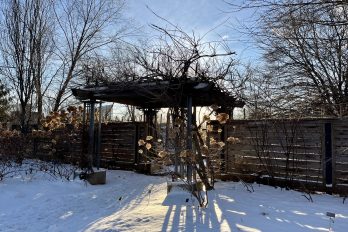Distinguishing between these two pollinators is easy, says Bug Lady Jean Godawa. But keeping them away from your outdoor buffet requires a few precautions.
Mosquitoes are no longer biting, aphids have disappeared from your plants and you haven’t seen a hungry caterpillar in weeks. Just when you thought you were rid of all the season’s pests and could enjoy the pleasant temperatures of autumn, more unwelcome visitors arrive.
Bees and wasps are very busy in late summer and early fall. Bees are collecting nectar from late-blooming flowers to keep their colony fed throughout the winter. But at this time of year, it’s wasps that are landing in your drinks and buzzing around your garbage and recycling bins by the dozens. Distinguishing between the two is easy—bees tend to be hairy and wasps are hairless.
Paper wasps, hornets and yellow jackets (Vespidae) are social wasps. While they make our autumn al fresco activities difficult, they are still beneficial insects. Throughout the spring and summer they collect a variety of insects, including many plant pests, to provide a protein-rich food for their immature colony members. Once the brood has matured, the workers’ responsibilities are complete. They disperse from their nest and throw a sort-of wasp retirement party. They won’t live much longer so they spend their last several days eating all the food they can find, usually at your expense—sweet carbohydrates are particular favourites.
Some wasps display swarming activity in the fall. This is associated with mating behaviour. Males die, usually with the first frost, and select mated females survive the winter to begin a new colony in the spring.
To prevent wasps from ruining your autumn outdoor dining, be sure to clean up any fallen fruit from nearby trees. Keep food well covered or indoors until you are ready to serve it, and remove dishes immediately after eating. Tolerating the increased activity of bees and wasps in the fall is important for ensuring a strong presence of these pollinators and predators in your garden next year.






